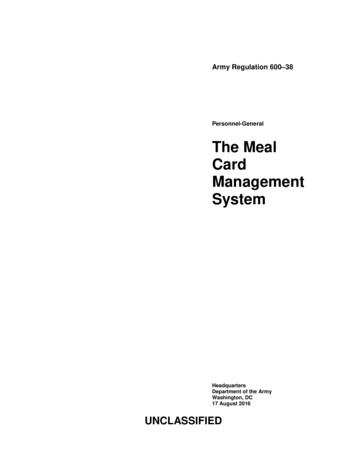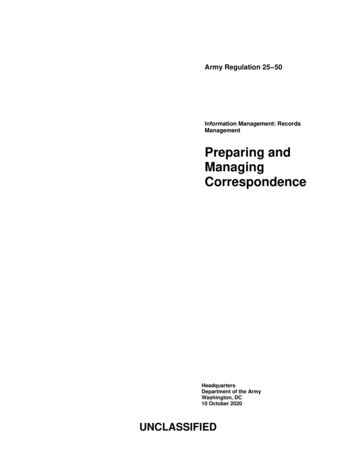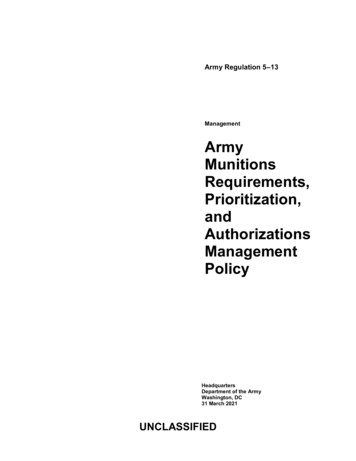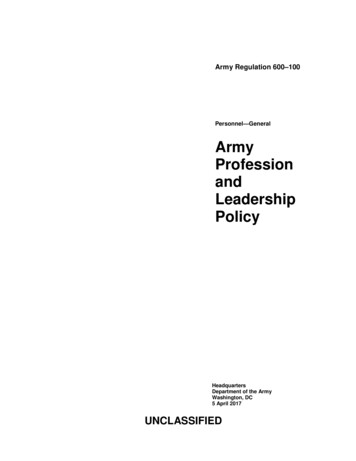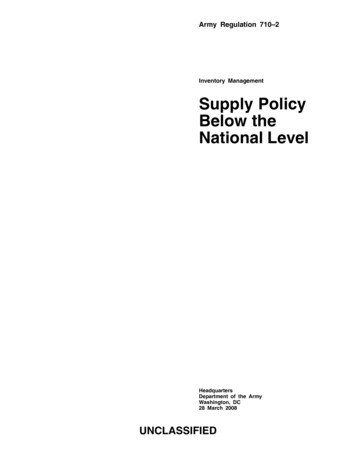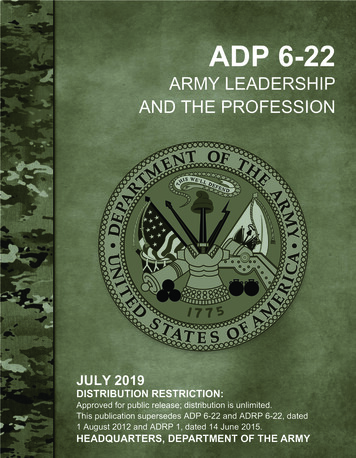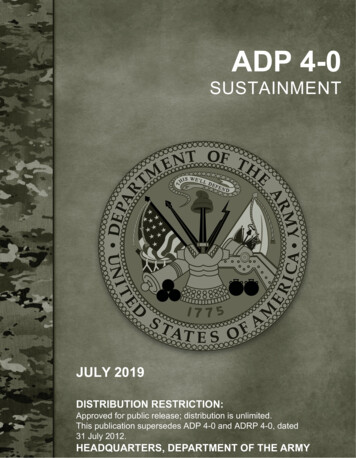
Transcription
ADP 4-0SUSTAINMENTJULY 2019DISTRIBUTION RESTRICTION:Approved for public release; distribution is unlimited.This publication supersedes ADP 4-0 and ADRP 4-0, dated31 July 2012.HEADQUARTERS, DEPARTMENT OF THE ARMY
ForewordSeldom will all logistics principles exert equal influence; usually one or two will dominatein any given situation. Identifying those principles that have priority in a specific situationis essential to establishing effective support. —JP 4-0, Doctrine for Logistics Support ofJoint Operations, Sep 25, 1992.The Army’s contribution to joint operations is unified land operations executed through decisive action andguided by the Army’s approach to command and control, mission command. ADP 4-0, Sustainment, is the Army’sprincipal sustainment doctrine that captures the most critical lessons from a decade of continuous, small scale,land combat. In this edition, we retain lessons of the past but also look to a future where large-scale combatoperations against peer threats is a distinct possibility. This publication builds on the idea that success requiresfully integrating Army sustainment operations with the efforts of unified action partners, across all domains, toachieve enduring outcomes.ADP 4-0 provides a common operational doctrine for sustaining Army forces operating across the full range ofmilitary operations in multiple domains of air, land, sea, space, and cyberspace. Army forces not engaged inongoing operations are focused on their readiness for future operations that require sustainment, training andprofessional education built on doctrine. ADP 4-0 informs the preparation, sustainment, and execution ofoperations. All leaders need to understand and be familiar with it.The central idea of unified land operations is that, as part of a joint force, Army forces seize, retain, and exploitthe initiative to gain a position of relative advantage in order to shape the operational environment, preventconflict, consolidate gains, and win our nation’s wars.ADP 4-0 is a continuation of the doctrine established in ADP 3-0, Operations. It describes the sustainmentwarfighting function and discusses the principles of sustainment. It discusses the elements of sustainment—logistics, financial management, personnel services and health service support and describes the sustainment ofunified action. ADP 4-0 discusses how sustainment provides operational reach, freedom of action and endurancein the execution of unified land operations. It emphasizes the connection between the strategic support area andoperational and tactical sustainment actions.ADP 4-0 serves as the sustainment doctrine for the Army. Its central idea, adapted to the unique conditions ofeach operational environment, represents how the Army sustains unified action. It will permeate our sustainmentdoctrine, our training, and our leader professional development programs now and into the future.RODNEY D. FOGGMAJOR GENERAL, UNITED STATES ARMYCOMMANDING
*ADP 4-0Army Doctrine PublicationNo. 4-0HeadquartersDepartment of the ArmyWashington, DC, 31 July 2019SustainmentContentsPagePREFACE. iiiINTRODUCTION . vChapter 1FUNDAMENTALS OF SUSTAINMENT . 1-1Sustainment Warfighting Function . 1-1Principles of Sustainment . 1-2Logistics Elements . 1-5Financial Management . 1-10Personnel Services . 1-11Human Resources Support . 1-11Health Service Support . 1-18Summary . 1-20Chapter 2SUSTAINMENT OF UNIFIED ACTION . 2-1Strategic Support Area . 2-1Army Sustainment Responsibilities . 2-2Joint Interdependence . 2-4Role of Institutional Army. 2-6Role of Operating Forces . 2-10Interorganizational Coordination . 2-16Multinational Coordination . 2-18Operational Contract Support . 2-20Summary . 2-22Chapter 3SUSTAINMENT OF UNIFIED LAND OPERATIONS . 3-1Operational Context . 3-1Sustainment Planning . 3-2Section I – Operational Reach . 3-4Army Pre-positioned Stocks . 3-4Force Projection . 3-6Theater Opening . 3-6Section II – Freedom of Action . 3-9Sustainment Preparation . 3-9Sustainment Execution . 3-10Section III – Endurance . 3-13Reconstitution . 3-13Distribution . 3-13DISTRIBUTION RESTRICTION: Approved for public release; distribution is unlimited.*This publication supersedes ADP 4-0 and ADRP 4-0 dated 31 July 2012.ADP 4-0i
ContentsTheater Closing . 3-15Summary . 3-17GLOSSARY . Glossary-1REFERENCES. References-1INDEX . Index-1FiguresIntroductory figure-1. ADP 4-0 logic chart. viFigure 1-1. Principles of sustainment . 1-3Figure 2-1. Competition continuum. . 2-1Figure 2-2. Joint deployment and distribution enterprise . 2-5Figure 2-3. Notional area of responsibility command and control of sustainment forces . 2-12Figure 2-4. Notional task organized division sustainment brigade for an armored division . 2-14Figure 2-5. Notional division sustainment support battalion . 2-15TablesIntroductory table-1. New and modified Army terms . viiTable 1-1. Classes of supply . 1-7This publication is available at the Army Publishing Directorate site(https://armypubs.army.mil), and the Central Army Registry d).iiADP 4-031 July 2019
PrefaceADP 4-0, Sustainment, expands the discussion on the overarching guidance on sustainment in ADP 3-0,Operations. It constitutes the Army’s view of how it supports prompt and sustained operations on land andsets the foundation for developing the other principles, tactics, techniques, and procedures detailed insubordinate doctrine publications. It also forms the basis for Army training and education system curricula.The principal audience for ADP 4-0 is all Army Soldiers and civilians who provide sustainment support aswell as those members of the Army profession who depend on and receive that support. Sustainmentcommanders and staffs of Army headquarters should also refer to applicable joint or multinational doctrineconcerning support to joint or multinational forces. Trainers and educators throughout the Army will also usethis publication as the foundation for training and education.To comprehend the doctrine contained in ADP 4-0, readers must first understand the fundamentals of unifiedland operations described in ADP 3-0. They must also understand the language of tactics and thefundamentals of Army operations described in FM 3-0, Operations.Commanders, staffs, and subordinates ensure that their decisions and actions comply with applicable UnitedStates, international, and in some cases host nation laws and regulations. Commanders at all levels ensurethat their Soldiers operate in accordance with the law of war and the rules of engagement. (See FM 27-10.)ADP 4-0 uses joint terms where applicable. Selected joint and Army terms and definitions appear in both theglossary and the text. Terms for which ADP 4-0 is the proponent publication (the authority) are italicized inthe text and are marked with an asterisk (*) in the glossary. Terms and definitions for which ADP 4-0 is theproponent publication are boldfaced in the text. For other definitions shown in the text, the term is italicizedand the number of the proponent publication follows the definition.ADP 4-0 applies to the Regular Army, Army National Guard of the United States, the Army National Guardwhile in the service of the United States, and the United States Army Reserve unless otherwise stated.United States Army Combined Arms Support Command (CASCOM) is the proponent for this publication.The preparing agency is the G-3/5/7 Doctrine Division, United States Army Combined Arms SupportCommand. Send written comments and recommendations on a DA Form 2028 (Recommended Changes toPublications and Blank Forms) to Commander, United States Army Combined Arms Support Command,ATTN: ATCL-TDID (ADP 4-0), 2221 Adams Avenue, Building 5020, Fort Lee, VA, 23801-1809; or submitan electronic DA Form 2028 by e-mail to: l.31 July 2019ADP 4-0iii
This page intentionally left blank.
IntroductionADP 4-0, Sustainment, is the Army’s doctrine for sustainment in support of operations. The doctrinediscussed in this manual is nested with ADP 3-0, Operations, and describes the sustainment warfightingfunction. The endurance of Army forces is primarily a function of their sustainment and is essential toretaining and exploiting the initiative. Sustainment provides the support necessary to maintain operationsuntil mission accomplishment. The relationship between sustainment and operation is depicted inintroductory figure-1 on page vi.Sustainment must be integrated and synchronized with operations at every level to include those of our jointand multinational partners. Sustainment depends on joint and strategic links for strategic airlift, sealift, intratheater airlift, and strategic and theater-level supply support. Sustainment depends on our host nation (HN)partners to provide infrastructure and logistics support necessary to ensure both maneuver forces and followon sustainment are delivered to right place, at the right time, and in an operable condition. This dependenceon our joint and strategic links and our multinational partners means sustainment is inherently joint. Throughjoint interdependence, the combatant commander (CCDR) is able to maximize the effect the Army’scapabilities in an operational area. The Army’s robust sustainment capability assists in providing theater andport opening functions enabling joint forces to conduct strategic and operational reach. Army sustainmentcapabilities provide the bulk of Army support to other services in the forms of executive agent, common-userlogistics, lead service, and other common sustainment resources. Army support to other services enables jointforces with freedom of action and endurance.ADP 4-0 contains three chapters:Chapter 1 discusses the four elements of the sustainment warfighting function: logistics, financialmanagement, personnel services, and health service support. It establishes the principles for each of theelements.Chapter 2 describes the important roles that the United States (U.S.) military and interorganizational partnersplay during the sustainment of Army forces. It describes joint interdependence and how sustaining the Armyand joint forces are linked. It also describes the Army’s Title 10 responsibilities and the roles of the generatingforce, operating force, interorganizational coordination and multinational partners in providing sustainment.Chapter 3 discusses unified land operations in an operational context and continues with a description ofcommand and control of sustainment forces. This chapter concludes with describing how sustainmentprovides operational reach, freedom of action and endurance to combat forces.For the purpose of this manual, the use of the terms sustainment headquarters and sustainment commandrefers to those organizations that provide one or more of the elements of the sustainment warfighting function.31 July 2019ADP 4-0v
IntroductionIntroductory figure-1. ADP 4-0 logic chartviADP 4-031 July 2019
IntroductionTerms for which ADP 4-0 is the proponent are listed in introductory table-1. These terms also appear in theglossary.Introductory table-1. New and modified Army termsTerm or AcronymRemarksanticipationADP 4-0 is now the proponent for the term.container managementADP 4-0 is now the proponent for the term.continuityADP 4-0 is now the proponent for the term.distribution managementModifies the definition. ADP 4-0 is now the proponent for the term.economyADP 4-0 is now the proponent for the term.field servicesADP 4-0 is now the proponent for the term.improvisationADP 4-0 is now the proponent for the term.integrationADP 4-0 is now the proponent for the term.intermodal operationsATP 4-13 is now the proponent for the term.logisticsADP 4-0 is now the proponent for the term.mode operationsADP 4-0 is now the proponent for the term.movement control (Army)ADP 4-0 is now the proponent for the term.personnel servicesADP 4-0 is now the proponent for the term.port openingADP 4-0 is now the proponent for the term.responsivenessADP 4-0 is now the proponent for the term.simplicityADP 4-0 is now the proponent for the term.sustainmentModifies the definition. ADP 4-0 is now the proponent for the term.sustainment preparation of theoperational environmentADP 4-0 is now the proponent for the term.theater openingADP 4-0 is now the proponent for the term.theater closingADP 4-0 is now the proponent for the term.31 July 2019ADP 4-0vii
This page intentionally left blank.
Chapter 1Fundamentals of SustainmentFor the Army, sustainment is the provision of logistics, financial management,personnel services, and health service support necessary to maintain operations untilsuccessful mission completion. Sustainment is accomplished through the coordination,integration, and synchronization of resources from the strategic level through thetactical level in conjunction with our joint and multinational partners.Sustainment operations enable force readiness. Sustainment operations maintain Armyforces by equipping it with materiel, funding it with required resources, staffing it withtrained Soldiers and leaders, and by providing it with the force health protectionneeded.Army sustainment is based on an integrated process (people, systems, materiel, healthservice support, and other support) inextricably linking sustainment to operations. Theconcept focuses on building an operational ready Army, delivering it to the CCDR aspart of the joint force, and sustaining its combat power across the depth of theoperational area and with unrelenting endurance.SUSTAINMENT WARFIGHTING FUNCTIONThe sustainment warfighting function is one of the eightSustainment Warfighting Functionelements of combat power: leadership, information, Logisticscommand and control, movement and maneuver,intelligence, fires, sustainment, and protection (See ADP Financial Management3-0). The sustainment warfighting function is the related Personnel Servicestasks and systems that provide support and services to Health Service Supportensure freedom of action, extended operational reach,and prolong endurance (ADP 3-0). Sustainmentdetermines the depth and duration of Army operations (ADP 3-0). Successful sustainment enables freedomof action by increasing the number of options available to the commander. Sustainment is essential forretaining and exploiting the initiative. The sustainment warfighting function consists of four elements:logistics, financial management, personnel services and health service support as shown in the sustainmentwarfighting function logic chart (Introductory figure-1).LOGISTICS1-1. Logistics is planning and executing the movement and support of forces. It includes those aspectsof military operations that deal with: design and development; acquisition, storage, movement,distribution, maintenance, and disposition of materiel; acquisition or construction, maintenance,operation, and disposition of facilities; and acquisition or furnishing of services. The explosive ordnancedisposal tasks are discussed under the protection warfighting function. Army logistics elements are:maintenance, transportation, supply, field services, distribution, operational contract support, and generalengineering. For additional details, see FM 4-95.31 July 2019ADP 4-01-1
Chapter 1FINANCIAL MANAGEMENT1-2. Financial management leverages fiscal policy and economic power across the range of militaryoperations. Financial management encompasses finance operations and resource management. For additionaldetails, see FM 1-06.PERSONNEL SERVICES1-3. Personnel services are sustainment functions that man the force, maintain Soldier and Familyreadiness, promote the moral and ethical values of the Nation, and enable the fighting qualities of theArmy. Personnel services include planning, coordination, and sustaining personnel efforts at the operationaland tactical levels. Personnel services include human resources support, legal support, religious support, andband support. For additional details, see FM 1-0, FM 1-04, FM 1-05, FM 1-06, and ATP 1-19.HEALTH SERVICE SUPPORTArmy Health System (AHS) support includes both health service support and force health protectionthat are critical capabilities embedded within formations across all warfighting functions. The force healthprotection mission falls under the protection warfighting function and will not be covered in this publication(see ADP 3-37). For additional details on health service support and the AHS see FM 4-02.Health service support encompasses all support and services performed, provided, and arranged by theArmy Medical Department to promote, improve, conserve, or restore the behavioral and physical well-beingof Army personnel and as directed, unified action partners (UAPs). Health service support includes thefollowing— Casualty care, which encompasses a number of medical functions, including: Medical treatment (organic and area medical support). Hospitalization. Dental care (treatment aspects). Behavioral health/neuropsychiatric treatment. Clinical laboratory services. Treatment of chemical, biological, radiological, and nuclear patients). Medical evacuation (including medical regulating). Medical logistics (including blood management).PRINCIPLES OF SUSTAINMENT1-6. The principles of sustainment shown in figure 1-1 are essential to maintaining combat power, enablingstrategic and operational reach, and providing Army forces with endurance. While these principles areindependent, they are also interrelated and must be synchronized in time, space, and purpose. The principlesof sustainment and the principles of logistics are the same.1-2ADP 4-031 July 2019
Fundamentals of SustainmentFigure 1-1. Principles of sustainmentINTEGRATION1-7. Integration is combining all of the sustainment elements within operations assuring unity ofcommand and effort. It requires deliberate coordination and synchronization of sustainment with operationsacross all levels of war. Army forces integrate sustainment with joint and multinational operations tomaximize the complementary and reinforcing effects of each Service component’s and other UAPs resources.One of the primary functions of the sustainment staff is to ensure the integration of sustainment withoperations plans.ANTICIPATION1-8. Anticipation is the ability to foresee operational requirements and initiate necessary actions thatmost appropriately satisfy a response without waiting for operations orders or fragmentary orders. Itis shaped by professional judgment resulting from experience, knowledge, education, intelligence, andintuition. Commanders and staffs must understand and visualize future operations and identify appropriateor required support. They must then start the process of acquiring the resources and capabilities that bestsupport the operation. Anticipation is facilitated by automation systems that provide the common operationalpicture upon which judgments and decisions are based. Commanders integrate risk management into theoperations process to identify threats, assess those threats, and emplace controls to mitigate the risk of gapsin support. Anticipation is also a principle of personnel services.RESPONSIVENESS1-9. Responsiveness is the ability to react to changing requirements and respond to meet the needs tomaintain support. It is providing the right support in the right place at the right time. It includes the abilityto anticipate operational requirements. Responsiveness is facilitated by a common operational picture31 July 2019ADP 4-01-3
Chapter 1facilitated by the Army Readiness-Common Operating Picture, and follow-on business intelligence toolsassociated with Army enterprise resource planning systems. That common operational picture enablescommanders to see all supported forces, anticipate requirements based on situational understanding, andprovide support when and where needed. Responsiveness involves identifying, accumulating, andmaintaining sufficient resources, capabilities, and information necessary to meet rapidly changingrequirements. Through responsive sustainment, commanders maintain operational focus and pressure, set thetempo of friendly operations to prevent exhaustion, replace ineffective units, and extend operational reach.SIMPLICITY1-10. Simplicity relates to processes and procedures to minimize the complexity of sustainment.Unnecessary complexity of processes and procedures leads to confusion. Clarity of tasks, standardized andinteroperable procedures, and clearly defined command relationships contribute to simplicity. Simplicityenables economy and efficiency in the use of resources, while ensuring effective support of forces. Simplicityis also a principle of financial management.ECONOMY1-11. Economy is providing sustainment resources in an efficient manner that enables the commanderto employ all assets to the greatest effect possible. Economy is achieved through efficient management,discipline, prioritization, and allocation of resources. Economy is further achieved by eliminatingredundancies and capitalizing on joint interdependencies. Disciplined sustainment assures greatest possibletactical endurance and constitutes an advantage to commanders. Economy may be achieved by contractingfor support or using HN resources that reduce or eliminate the use of limited military resources. By efficientlyand ethically managing Army resources, Army professionals are stewards who act in the best interest of theAmerican people.SURVIVABILITY1-12. Survivability is all aspects of protecting personnel, weapons, and supplies while simultaneouslydeceiving the enemy (JP 3-34). Survivability consists of a quality or capability of military forces to avoid orwithstand hostile actions or environmental conditions while retaining the ability to fulfill their primarymission. This quality or capability of military forces is closely related to protection (the preservation of amilitary force’s effectiveness) and to the protection/force protection warfighting function (the tasks orsystems that preserve the force). Hostile actions and environmental conditions can disrupt the flow ofsustainment and significantly degrade forces’ ability to conduct and sustain operations. In mitigating risks tosustainment, commanders often must rely on the use of redundant sustainment capabilities and alternativesupport plans.CONTINUITY1-13. Continuity is the uninterrupted provision of sustainment across all levels of war. Continuity isachieved through a system of integrated and focused networks linking sustainment to operations. Continuityis achieved through joint interdependence; linked sustainment organizations; a strategic to tactical leveldistribution system, and integrated information systems. Continuity assures confidence in sustainmentallowing commanders freedom of action, operational reach, and endurance.IMPROVISATION1-14. Improvisation is the ability to adapt sustainment operations to unexpected situations orcircumstances affecting a mission. It includes creating, arranging, or fabricating resources to meetrequirements. It may also involve changing or creating methods that adapt to a changing operationalenvironment. Sustainment leaders must apply operational art to visualize complex operations and understandadditional possibilities. These skills enable commanders to improvise operational and tactical actions whenenemy actions or unexpected events disrupt sustainment operations. While deception is related tosurvivability in that deception contributes to survivability, improvisation is where logisticians can activelyachieve deception of enemy forces. Improvisation is also a principle of financial management.1-4ADP 4-031 July 2019
Fundamentals of SustainmentLOGISTICS ELEMENTS1-15. Logistics is planning and executing the movement and support of forces. It includes those aspects ofmilitary operations that deal with design and development; acquisition, storage, movement, distribution,maintenance, and disposition of materiel; acquisition or construction, maintenance, operation, and dispositionof facilities; and acquisition or furnishing of services. For the sustainment warfighting function, explosiveordnance disposal tasks are discussed under protection and intelligence warfighting functions (ADP 3-37 andFM 2-0.) Army logistics include the following— Maintenance. Transportation. Supply. Field services. Distribution. Operational contract support. General engineering support.1-16. Logistics involves both operational art and science. Knowing when and how to accept risk, when andhow to prioritize a myriad of requirements and how to balance limited resources all require operational art.While, understanding equipment capabilities, consumption rates, operational contract support and hostnation support (HNS) require science. Logistics integrates strategic, operational, and tactical support ofdeployed forces while scheduling the mobilization and deployment of additional forces and materiel.MAINTENANCE1-17. Maintenance is all actions taken to retain materiel in a serviceable condition or to restore it toserviceability. The Army utilizes a tiered, two-level maintenance system composed of field and sustainmentmaintenance. Command teams, maintenance personnel and planners must have a complete understanding oftwo-level maintenance fundamentals in order to properly plan and execute their mission. Maintenance isnecessary for endurance and performed at the tactical through strategic levels of war. See ATP 4-33 for moreinformation.Field Maintenance1-18. Field maintenance is on or near system maintenance, repair and return of equipment to the userincluding maintenance actions performed by operators (ATP 4-33). It often includes replaceable line unit andcomponent replacement, and battle damage assessment, repair, and recovery. It is focused on returning asystem to an operat
31 July 2019 ADP 4-0 v . Introduction . ADP 4-0, Sustainment, is the Army’s doctrine for susta



